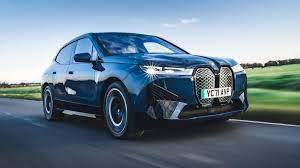The world’s biggest battery makers are working to make electric vehicles more attractive to hesitant buyers by offering a five-minute charge time for a decent range that would give drivers the same superfast experience as they would have at a gas station.
Currently, the charging times for EVs range anywhere from 20 minutes to 50 or more hours, depending on the charger types and speeds, as well as the vehicle battery capacity.
Some battery makers have recently unveiled batteries capable of charging to 80 percent in fewer than 10 minutes and say that technological advances will soon lead to the five-minute charge that would revolutionize the EV driving experience.
However, experts point to faster exhaustion of the battery’s lifespan in excessive superfast charging and increased risks of battery fires with overheating during the under-10-minute charge.
In addition, the lack of superfast charging is only one of the current anxieties for drivers considering buying an EV. Others include not enough public charging points for a convenient car trip at longer distances, the cost of buying and keeping an EV with uncertainties about incentives, and expensive battery replacement.
The 10-Minute Charge Breakthrough
The Chinese battery manufacturers are leading in the race to superfast charging as their lithium iron phosphate (LFP) batteries are not as susceptible to overheating as the nickel-cobalt chemistry in the batteries of their competitors in South Korea.
China’s Contemporary Amperex Technology Co., Limited (CATL), the world’s biggest battery maker, which supplies batteries to Tesla and BMW, among others, unveiled in April the world’s first LFP battery that achieves a range above 1,000 kilometers (620 miles) with 4C superfast charging.
Aside from offering long range, the battery, called Shenxing PLUS, also charges fast, CATL says. It can deliver a 600-km (372-mile) range in just 10 minutes of charging, “far surpassing the usual batteries available on the market and realizing a true superfast charging speed of one kilometer per second,” according to the Chinese firm.
Another Chinese battery manufacturer, Gotion High-tech, unveiled in May an ultra-fast charging G-Current battery ready for immediate mass production. The company says that the battery enables an 80% charge with 9.8 minutes of charging and 90% energy replenishment with 15 minutes of charging.
Gotion High-tech claims that “this solution can be applied to the entire range of battery applications, BEVs or hybrid vehicles, covering LFP, LMFP, and NCM chemistry systems.”
China Pulls Ahead
China’s focus on the LFP gives it an edge over South Korean competitors such as LG Energy Solution, Samsung SDI, and SK Innovation.
The LFP cathodes have gained popularity due to their low cost and thermal stability, Yingchi Yang, a consultant at Wood Mackenzie’s Battery Raw Material Service, says.
Unlike nickel-based cathodes, LFP cathodes do not contain expensive metals, such as cobalt and nickel, which makes them an attractive option for manufacturers looking to reduce costs, Yang notes.
South Korea’s LG Chem, the parent company of LG Energy Solution, may have the answer to preventing batteries from overheating.
LG Chem announced last week that it has developed a temperature-responsive material to suppress thermal runaway. The material, as thin as 1/100 the diameter of a human hair, is placed inside the battery cell and acts as a “fuse” to block the reaction path at the early stages of overheating. The research breakthrough could be applied to mass production “in a short period,” said CTO Lee Jong-gu.
“We will enhance safety technologies so that customers can use electric vehicles with confidence, and further strengthen our competitiveness in the battery market,” the executive added.
Challenges Ahead
Yet, there are experts who say that evidence has shown that superfast charging could reduce the lifespan of the vehicle’s battery, Lee Hang-koo, head of the Jeonbuk Institute of Automotive Convergence Technology in South Korea, told the Financial Times.
Moreover, charging speed is not the top concern of potential EV buyers, Lee said.
“According to recent polls, consumers think lowering EV prices and having long ranges are more important than charging speed,” Lee told FT, noting that “consumers want to see more charging facilities more than they want to see faster charging.”
The EY Mobility Consumer Index, an annual survey of consumers, showed last month that despite record U.S. consumer interest in EVs in 2023, only 34% of U.S. consumers intend to purchase an EV as their next car in 2024. That share is down by 14 percentage points compared to last year’s survey, “proving that EV education is not where it needs to be and barriers to mass EV adoption still exist,” EY said.
While U.S. consumer confidence in infrastructure has been growing, this has been overshadowed by increasing concerns about battery life and maintenance fees.
Expensive battery replacement was the top deterrent to purchasing an EV for U.S. consumers, overtaking the lack of charging stations for the first time, the EY survey found.
The poll also showed that hybrid vehicles have risen in popularity, and this rise can be attributed to the overall versatility of these vehicles, EY says, adding that “hybrid vehicles prove a transitional bridge may be necessary.”

 Iran Energy News Oil, Gas, Petrochemical and Energy Field Specialized Channel
Iran Energy News Oil, Gas, Petrochemical and Energy Field Specialized Channel



